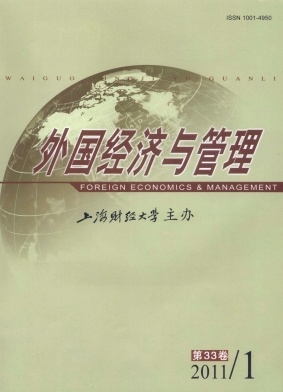国外团队断裂带研究现状评介与未来展望
外国经济与管理 2011 年 第 33 卷第 01 期, 页码:34 - 42
摘要
参考文献
摘要
本文基于国外团队断裂带的已有研究,从其概念提出与演进、测量方法与技术、效能作用及现有研究的不足等方面进行了评述,并在评介研究现状的基础上比较系统地提出了有关未来研究的设想和建议。
[1]Jehn,K A,and Bezrukova,K.The faultline activation process and the effects of activated faultlines on coalition formation,con-flict,and group outcomes[J].Organizational Behavior and Human Decision Processes,2010,112(1):24-42.
[2]Bezrukova,K,Jehn,K A,Zanutto,E L,and Thatcher,S MB.Do workgroup faultlines help or hurt?A moderated model of fault-lines,teamidentification,and group performance[J].Organization Science,2009,20(1):35-50.
[3]Van Knippenberg,D,De Dreu,C,and Homan,A C.Work group diversity and group performance:An integrative model and re-search agenda[J].Journal of Applied Psychology,2004,89(6):1 008-1 022.
[4]Lau,D C,and Murnighan,J K.Demographic diversity and faultlines:The compositional dynamics of organizational groups[J].Academy of Management Review,1998,23(2):325-340.
[5]Homan,A C,Van Knippenberg,D,Van Kleef,G A,and De Dreu,K W.Bridging faultlines by valuing diversity:Diversity beliefs,information elaboration,and performance in diverse work groups[J].Journal of Applied Psychology,2007,92(5):1 189-1 199.
[6]Huber,G P,and Lewis,K.Cross-understanding:I mplications for group cognition and performance[J].Academy of ManagementReview,2010,35(1):6-26.
[7]Williams,K,and O’Reilly,C A.Demography and diversity in organizations:Areviewof 40 years of research[J].Researchin Or-ganizational Behavior,1998,20(1):77-140.
[8]Gratton,L,Voigt,A,and Erickson,T.Bridging faultlines in diverse teams[J].Sloan Management Review,2007,48(4):22-29.
[9]Webber,S,and Donahue,L.I mpact of highly and less job related diversity on work group cohesion and performance:A meta-analysis[J].Journal of Management,2001,27(2):141-162.
[10]Lau,D C,and Murnighan,J K.Interactions within groups and subgroups:The effects of demographic faultlines[J].Academy ofManagement Journal,2005,48(4):645-659.
[11]Li,J T,and Hambrick,D C.factional groups:A New vantage on demographic faultlines,conflict,and disintegration in workteams[J].Academy of Management Journal,2005,48(5):794-813.
[12]Dyck,B,and Starke,F A.The formation of breakaway organizations:Observations and a process model[J].Administrative Sci-ence Quarterly,1999,44(4):792-822.
[13]Thatcher,S MB,Jehn,K A,and Zanutto,E.Cracks in diversity research:The effects of diversity faultlines on conflict and per-formance[J].Group Decision and Negotiation,2003,12(3):217-241.
[14]Shaw,J B.The development and analysis of a measure of groupfaultlines[J].Organizational Research Methods,2004,7(1):66-99.
[15]Edmondson,A C,and Mc Manus,S E.Methodological fit in management field research[J].Academy fo management Review,2007,32(4):1 155-1 179.
[16]Hart,C M,and Van Vugt,M.Fromfaultline to groupfission:Understanding membership changesin small groups[J].Personali-ty and Social Psychology Bulletin,2006,32(3):392-404.
[17]Gibson,C,and Vermeulen,F.A healthy divide:Subgroups as a sti mulus for teamlearning behavior[J].Administrative ScienceQuarterly,2003,48(2):202-239.
[18]Pearsall,MJ,Ellis,A P J,and Evans,J M.Unlocking the effects of gender faultlines on teamcreativity:Is activation the key?[J].Journal of Applied Psychology,2008,93(1):225-234.
[19]Cramton,C D,and Hinds,PJ.Subgroup dynamicsininternationally distributed teams:Ethnocentrismof cross-national learning?[J].Researchin Organizational Behavior,2005,26(1):231-263.
[20]Harrison,D A,Price,K H,Gavin,J H,and Florey,A T.Ti me,teams,andtask performance:Changing effects of surface and deeplevel diversity on group functioning[J].Academy of Management Journal,2005,45(5):1 029-1 045.
[2]Bezrukova,K,Jehn,K A,Zanutto,E L,and Thatcher,S MB.Do workgroup faultlines help or hurt?A moderated model of fault-lines,teamidentification,and group performance[J].Organization Science,2009,20(1):35-50.
[3]Van Knippenberg,D,De Dreu,C,and Homan,A C.Work group diversity and group performance:An integrative model and re-search agenda[J].Journal of Applied Psychology,2004,89(6):1 008-1 022.
[4]Lau,D C,and Murnighan,J K.Demographic diversity and faultlines:The compositional dynamics of organizational groups[J].Academy of Management Review,1998,23(2):325-340.
[5]Homan,A C,Van Knippenberg,D,Van Kleef,G A,and De Dreu,K W.Bridging faultlines by valuing diversity:Diversity beliefs,information elaboration,and performance in diverse work groups[J].Journal of Applied Psychology,2007,92(5):1 189-1 199.
[6]Huber,G P,and Lewis,K.Cross-understanding:I mplications for group cognition and performance[J].Academy of ManagementReview,2010,35(1):6-26.
[7]Williams,K,and O’Reilly,C A.Demography and diversity in organizations:Areviewof 40 years of research[J].Researchin Or-ganizational Behavior,1998,20(1):77-140.
[8]Gratton,L,Voigt,A,and Erickson,T.Bridging faultlines in diverse teams[J].Sloan Management Review,2007,48(4):22-29.
[9]Webber,S,and Donahue,L.I mpact of highly and less job related diversity on work group cohesion and performance:A meta-analysis[J].Journal of Management,2001,27(2):141-162.
[10]Lau,D C,and Murnighan,J K.Interactions within groups and subgroups:The effects of demographic faultlines[J].Academy ofManagement Journal,2005,48(4):645-659.
[11]Li,J T,and Hambrick,D C.factional groups:A New vantage on demographic faultlines,conflict,and disintegration in workteams[J].Academy of Management Journal,2005,48(5):794-813.
[12]Dyck,B,and Starke,F A.The formation of breakaway organizations:Observations and a process model[J].Administrative Sci-ence Quarterly,1999,44(4):792-822.
[13]Thatcher,S MB,Jehn,K A,and Zanutto,E.Cracks in diversity research:The effects of diversity faultlines on conflict and per-formance[J].Group Decision and Negotiation,2003,12(3):217-241.
[14]Shaw,J B.The development and analysis of a measure of groupfaultlines[J].Organizational Research Methods,2004,7(1):66-99.
[15]Edmondson,A C,and Mc Manus,S E.Methodological fit in management field research[J].Academy fo management Review,2007,32(4):1 155-1 179.
[16]Hart,C M,and Van Vugt,M.Fromfaultline to groupfission:Understanding membership changesin small groups[J].Personali-ty and Social Psychology Bulletin,2006,32(3):392-404.
[17]Gibson,C,and Vermeulen,F.A healthy divide:Subgroups as a sti mulus for teamlearning behavior[J].Administrative ScienceQuarterly,2003,48(2):202-239.
[18]Pearsall,MJ,Ellis,A P J,and Evans,J M.Unlocking the effects of gender faultlines on teamcreativity:Is activation the key?[J].Journal of Applied Psychology,2008,93(1):225-234.
[19]Cramton,C D,and Hinds,PJ.Subgroup dynamicsininternationally distributed teams:Ethnocentrismof cross-national learning?[J].Researchin Organizational Behavior,2005,26(1):231-263.
[20]Harrison,D A,Price,K H,Gavin,J H,and Florey,A T.Ti me,teams,andtask performance:Changing effects of surface and deeplevel diversity on group functioning[J].Academy of Management Journal,2005,45(5):1 029-1 045.
引用本文
谢小云, 张倩. 国外团队断裂带研究现状评介与未来展望[J]. 外国经济与管理, 2011, 33(1): 34–42.
导出参考文献,格式为:
上一篇:论组织的复杂性





 7000
7000  302
302

